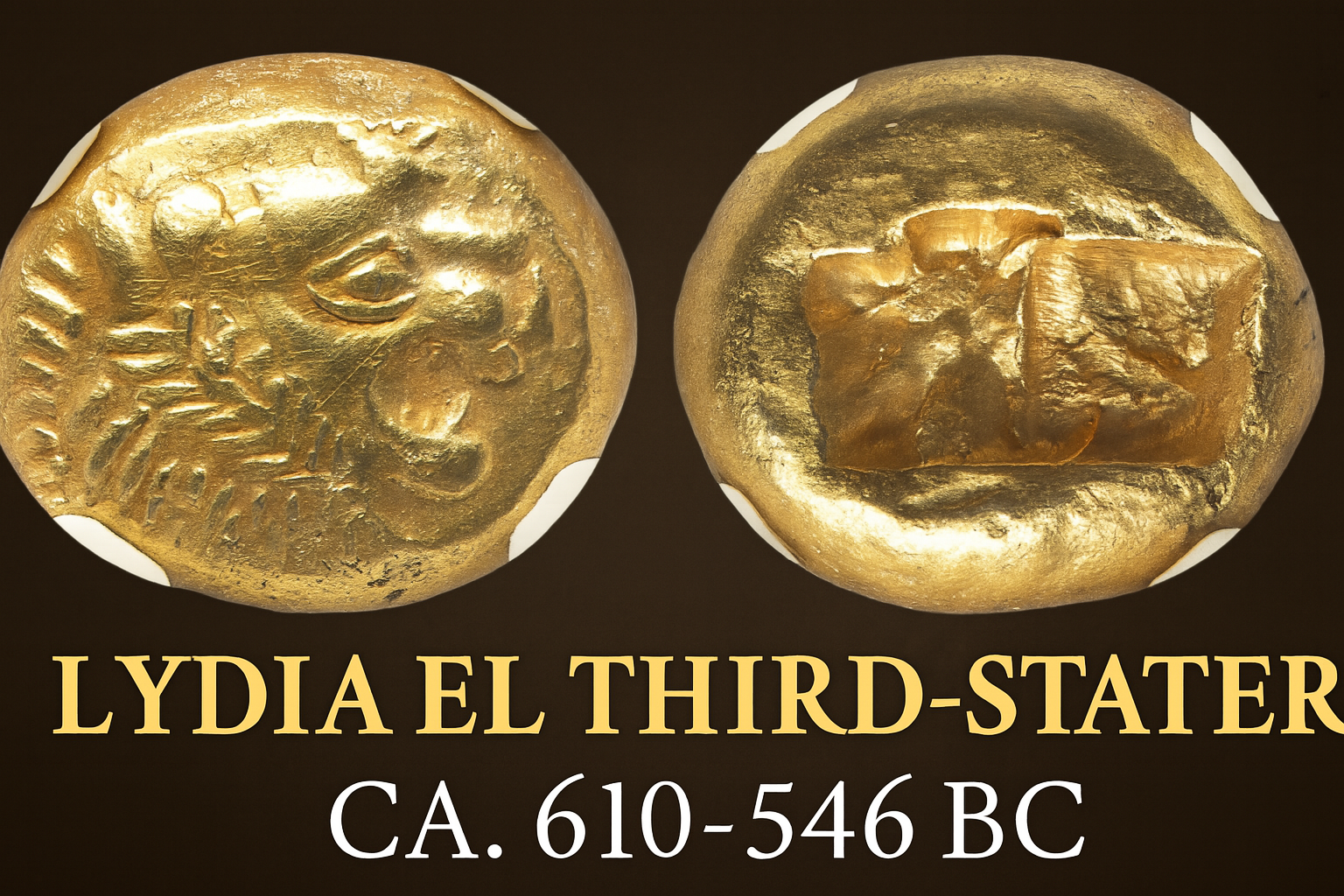The World’s First Coin: Why Lydia’s EL Third-Stater Is a Must-Have for Serious Collectors

Part 1: A Glimpse into the Birth of Coinage
Imagine holding in your hand not just a coin—but the prototype of money itself. Struck over 2,600 years ago in the ancient kingdom of Lydia (modern-day western Turkey), the EL Third-Stater, also known as the Trite, is widely recognized as one of the first coins ever minted.
Issued under King Alyattes (or Walwet in the local Lydian language), this coin predates most ancient Greek and Roman currency and marks the dawn of monetary economies. The coin features a fierce lion’s head—a royal emblem of strength and divine power—on the obverse, and a pair of deeply-punched squares (called incuses) on the reverse, typical of early electrum coinage.
What makes these coins even more astonishing is their composition: electrum, a naturally occurring alloy of gold and silver, extracted from the legendary Pactolus River, where myth says King Midas washed away his golden curse.
Part 2: Specifications and Rarity—Why Investors Take Notice
The Lydia EL Third-Stater sold by Heritage Auctions in May 2025 fetched a commanding price of ¥849,640 (approx. $3,600), underscoring the coin’s enduring desirability. Graded Choice AU (Strike 4/5, Surface 3/5) by NGC, this particular example boasts remarkable preservation for an archaic coin.
Here are its key attributes:
-
Date: Circa 610–546 BC
-
Metal: Electrum (approx. 54% gold, 44% silver)
-
Weight: ~4.73 grams
-
Diameter: ~13 mm
-
Mint: Sardis, capital of ancient Lydia
-
Obverse: Lion’s head with a radiating star symbol
-
Reverse: Two irregular incuse punches
-
Denomination: One-third stater (Trite)
Coins like these were not only used for commerce but also found as temple offerings—most famously at the Temple of Artemis at Ephesus, one of the Seven Wonders of the Ancient World. Their presence in religious and economic spheres points to their high value even in antiquity.
Due to their scarcity and historical significance, high-quality Lydia Third-Staters often sell for $4,000–$10,000+, especially when featuring rare inscriptions like 'WALWET.'
Part 3: Historical Significance and Kingly Legacy
The EL Third-Stater is inseparably tied to the reign of King Alyattes, one of Lydia’s most influential monarchs. He laid the foundation for the kingdom’s prosperity, setting the stage for his son, the legendary Croesus, whose name became synonymous with immense wealth.
Alyattes’ innovation wasn’t just military or economic—it was monetary. By standardizing chunks of electrum into coinage backed by royal authority, he introduced a revolutionary financial system. No longer did merchants need to weigh and test each piece of metal; these coins offered trust, uniformity, and instant value.
This shift had immense implications. It enabled faster trade, better taxation, and ultimately the expansion of empires. This is why financial historians consider the Lydia Trite not just a coin, but the birth certificate of modern money.
Part 4: Investment Appeal in the Modern Era
For today’s investor or high-end collector, the Lydia EL Third-Stater represents a rare opportunity to own a piece of the world’s financial origin story. These coins are part historical artifact, part investment-grade asset. Unlike modern bullion, their value does not merely track gold—it reflects their narrative, condition, and rarity.
In recent auctions:
-
A Choice AU example (like the one highlighted here) sold for $3,600
-
An exceptional “WALWET” inscribed type reached $10,000
-
Even lower-grade examples command thousands due to scarcity
As global interest in tangible assets with historical significance grows, coins like these offer portfolio diversification and cultural prestige in one.
Final Thoughts
For those seeking not just a coin, but a cornerstone of civilization, the Lydia EL Third-Stater delivers in spades. It’s more than gold—it’s the beginning of money. Whether you’re expanding a world-class collection or anchoring an alternative investment portfolio, this ancient coin is a symbol of timeless value.
Interested in acquiring one? Be sure to work with reputable auction houses and grading services like NGC or PCGS to ensure authenticity and long-term value.
